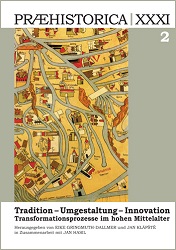Mittelalterliche Agrarwirtschaft und Wüstungsbildung in Westfalen
Rural Economy and Desertion in Medieval Westfalia
Author(s): Rudolf BergmannSubject(s): Archaeology, Agriculture, Economic history, Middle Ages, Rural and urban sociology, Economic development
Published by: Univerzita Karlova v Praze, Nakladatelství Karolinum
Keywords: medieval rural economy in Westfalia; plaggen esch economy; medieval plough types; harvesting implements; river fishing and fishponds; medieval desertion;
Summary/Abstract: Focusing on rural economy Westfalia offers a wide range of different agricultural systems. This includes the plaggen-esch economy of the Muensterland (see Abb. 1), individual single farmstead farming within the central Muensterland, and the open-field system of the Boerden with up to four fields already in the 14th century, crop rotation and fallow. Finds of plough-shares indicate that there is an interesting development from those of symmetric triangular form, dating back into the 10th/11th century (Abb. 4.2), to one of an asymmetric triangle (Abb. 5.1, 5.4) belonging to the characteristic ridge and furrow plough illustrated in the ‘Sachsenspiegel’. Desertion is often thought to be the main result of the late medieval crisis of agriculture. It has affected the landscapes to the West much less than those to the middle, South and East. As can be depicted from written sources and archaeology, desertion to a smaller amount started in the 12th century, was full in progress in the vicinity of towns in the 13th/14th century, and reached its peak at the end of the 14th century. Desertion had different reasons: In the Muensterland e.g. the local nobility drove out farmers in order to enlarge their self-managed estates in the vicinity of their moated castles. In the South-East of Westfalia feuds evoked the desertion of unprotected hamlets (with no steady effect on the arable) and encouraged settlement concentration. Whilst feuds were still on progress, the arrival of the Black Death in the middle of the 14th century created an immense lack of population and led to the total depopulation of certain areas. In others the lack of cultivators was partly compensated by social classes of the rural society, that had no lands up to this time, as well as by the creation of bigger yardlands. Desertion was mainly a process of predominant settlement concentration which allowed arable to fall out of use temporarily. Owing to this fact fossilised medieval field systems like those of terraced fields in the mountainous South (see Abb. 2) and the ridge and furrow open-fields of the far South East of Westfalia (see Abb. 3) are rare.
Journal: Praehistorica
- Issue Year: 31/2013
- Issue No: 2
- Page Range: 585-612
- Page Count: 28
- Language: German

